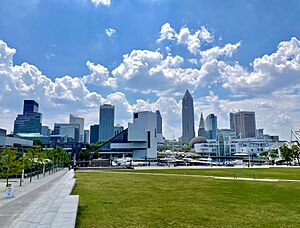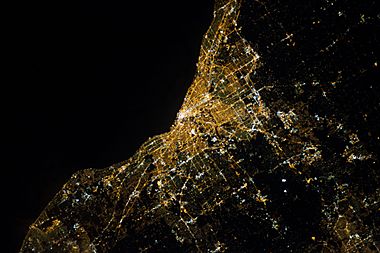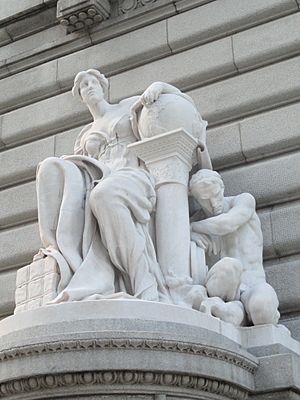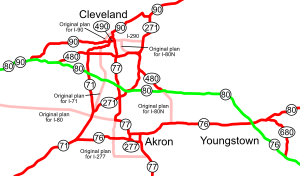Greater Cleveland facts for kids
Quick facts for kids
Greater Cleveland
|
|
|---|---|
| Cleveland, OH Metropolitan Statistical Area | |

Downtown Cleveland
|
|
| Country | |
| State | |
| Largest city | Cleveland |
| Other cities in MSA | |
| Population
(2020)
|
|
| • MSA | 2,185,825 (33rd) |
| • CSA | 3,769,834 (17th) |
| GDP | |
| • MSA | $162.8 billion (2022) |
| Time zone | UTC−5 (EST) |
| • Summer (DST) | UTC−4 (EDT) |
| Area code(s) | 216, 234, 330, 436, 440 |
The Cleveland metropolitan area, often called Greater Cleveland, is the area around the city of Cleveland in Northeast Ohio, United States. In 2020, this area included six counties: Cuyahoga, Ashtabula, Geauga, Lake, Lorain, and Medina. It had a population of 2,185,825 people. This makes it the 33rd largest metropolitan area in the U.S. and the third largest in Ohio.
Greater Cleveland is also part of a bigger area called the Cleveland–Akron–Canton Combined Statistical Area. This larger area has over 3.7 million people. It is the most populated statistical area in Ohio and the 17th most populated in the United States.
Northeast Ohio is an even larger region. It has over 4.5 million residents. This article focuses on Greater Cleveland. However, some information also applies to the wider Northeast Ohio region. This region is historically known as the Connecticut Western Reserve.
Contents
Exploring Northeast Ohio
Northeast Ohio is made up of 16 counties. These include Ashland, Ashtabula, Carroll, Columbiana, Cuyahoga, Geauga, Lake, Lorain, Mahoning, Medina, Portage, Richland, Stark, Summit, Trumbull, and Wayne counties.
Major cities in Northeast Ohio include Akron, Ashland, Ashtabula, Canton, and Cleveland. About 4 million people live here. The region's economy produces nearly $170 billion in goods and services. Sometimes, other counties like Erie and Huron are also included. This brings the total population to over 4.5 million.
Cities and Towns in Greater Cleveland
Greater Cleveland includes many cities, townships, and villages. Here are some of them, organized by county:
Cuyahoga County Communities
- Bay Village
- Beachwood
- Bedford
- Bedford Heights
- Bentleyville
- Berea
- Bratenahl
- Brecksville
- Broadview Heights
- Brook Park
- Brooklyn
- Brooklyn Heights
- Chagrin Falls
- Chagrin Falls Township
- Cleveland
- Cleveland Heights
- Cuyahoga Heights
- East Cleveland
- Euclid
- Fairview Park
- Garfield Heights
- Gates Mills
- Glenwillow
- Highland Heights
- Highland Hills
- Hunting Valley
- Independence
- Lakewood
- Linndale
- Lyndhurst
- Maple Heights
- Mayfield Heights
- Mayfield Village
- Middleburg Heights
- Moreland Hills
- Newburgh Heights
- North Olmsted
- North Randall
- North Royalton
- Oakwood Village
- Olmsted Falls
- Olmsted Township
- Orange
- Parma
- Parma Heights
- Pepper Pike
- Richmond Heights
- Rocky River
- Seven Hills
- Shaker Heights
- Solon
- South Euclid
- Strongsville
- University Heights
- Valley View
- Walton Hills
- Warrensville Heights
- Westlake
- Woodmere
Ashtabula County Communities
- Andover
- Andover Township
- Ashtabula
- Ashtabula Township
- Austinburg Township
- Cherry Valley Township
- Colebrook Township
- Conneaut
- Conneaut Township
- Denmark Township
- Dorset Township
- Geneva
- Geneva-on-the-Lake
- Geneva Township
- Harpersfield Township
- Hartsgrove Township
- Jefferson
- Jefferson Township
- Kingsville Township
- Lenox Township
- Monroe Township
- Morgan Township
- New Lyme Township
- North Kingsville
- Orwell
- Orwell Township
- Pierpont Township
- Plymouth Township
- Richmond Township
- Roaming Shores
- Rock Creek
- Rome Township
- Saybrook Township
- Sheffield Township
- Trumbull Township
- Wayne Township
- Williamsfield Township
- Windsor Township
Geauga County Communities
- Auburn Township
- Bainbridge Township
- Burton
- Burton Township
- Chardon
- Chardon Township
- Chester
- Chesterland
- Claridon Township
- Hambden Township
- Hunting Valley (part)
- Huntsburg Township
- Middlefield
- Middlefield Township
- Montville Township
- Munson Township
- Newbury Township
- Parkman Township
- Russell Township
- South Russell
- Thompson Township
- Troy Township
- Hunting Valley (part)
Lake County Communities
- Concord Township
- Eastlake
- Fairport Harbor
- Grand River
- Kirtland
- Kirtland Hills
- Lakeline
- LeRoy Township
- Madison
- Madison Township
- Mentor
- Mentor-on-the-Lake
- North Madison
- North Perry
- Painesville
- Painesville Township
- Perry
- Perry Township
- Timberlake
- Waite Hill
- Wickliffe
- Willoughby
- Willoughby Hills
- Willowick
Lorain County Communities
- Amherst
- Amherst Township
- Avon
- Avon Lake
- Brighton Township
- Brownhelm Township
- Camden Township
- Carlisle Township
- Columbia Township
- Eaton Estates
- Eaton Township
- Elyria
- Elyria Township
- Grafton
- Grafton Township
- Henrietta Township
- Huntington Township
- Kipton
- Lagrange
- LaGrange Township
- Lorain
- New Russia Township
- North Ridgeville
- Oberlin
- Penfield Township
- Pittsfield Township
- Rochester
- Rochester Township
- Sheffield
- Sheffield Lake
- Sheffield Township
- South Amherst
- Vermilion (portions in Erie and Lorain Counties)
- Wellington
- Wellington Township
Medina County Communities
- Brunswick
- Brunswick Hills Township
- Chatham Township
- Chippewa Lake
- Creston
- Gloria Glens Park
- Granger Township
- Guilford Township
- Harrisville Township
- Hinckley Township
- Homer Township
- Lafayette Township
- Litchfield Township
- Liverpool Township
- Lodi
- Medina
- Medina Township
- Montville Township
- Rittman
- Seville
- Sharon Township
- Spencer
- Spencer Township
- Wadsworth
- Wadsworth Township
- Westfield Center
- Westfield Township
- York Township
Largest Cities by Population
Here are the twelve largest cities in Greater Cleveland, based on their 2020 populations:
| City | 2020 population |
|---|---|
| Cleveland | 372,624 |
| Parma | 81,146 |
| Lorain | 65,211 |
| Elyria | 52,656 |
| Lakewood | 50,942 |
| Euclid | 49,692 |
| Mentor | 47,450 |
| Strongsville | 46,491 |
| Cleveland Heights | 45,312 |
| North Ridgeville | 35,280 |
| Westlake | 34,228 |
| North Olmsted | 32,442 |
| North Royalton | 31,322 |
People and Cultures of Greater Cleveland
| Historical population | ||
|---|---|---|
| Year | Pop. | ±% |
| 1850 | 159,874 | — |
| 1860 | 193,501 | +21.0% |
| 1870 | 245,052 | +26.6% |
| 1880 | 321,638 | +31.3% |
| 1890 | 447,386 | +39.1% |
| 1900 | 603,807 | +35.0% |
| 1910 | 834,204 | +38.2% |
| 1920 | 1,169,422 | +40.2% |
| 1930 | 1,466,057 | +25.4% |
| 1940 | 1,500,798 | +2.4% |
| 1950 | 1,759,431 | +17.2% |
| 1960 | 2,220,050 | +26.2% |
| 1970 | 2,419,274 | +9.0% |
| 1980 | 2,277,949 | −5.8% |
| 1990 | 2,202,069 | −3.3% |
| 2000 | 2,250,871 | +2.2% |
| 2010 | 2,178,737 | −3.2% |
| 2020 | 2,185,825 | +0.3% |
| 2022* | 2,160,145 | −1.2% |
| * = Population estimate. Source: U.S. Decennial Census |
||
In 2020, the Greater Cleveland area had about 2.186 million people. This makes it the second largest metropolitan area completely within Ohio. About 48.1% of the people were male and 51.9% were female.

The average household income in Greater Cleveland was $46,231. The average family income was $59,611. About 15.1% of people lived below the poverty line. Cleveland is known for having many wealthy households. It is expected to grow even more in the coming years.
Greater Cleveland is the most diverse region in Ohio. It is becoming even more diverse. Many new people are moving there from other countries. Between 2000 and 2010, the number of Hispanic and Asian people grew by almost 40%. The area is home to many different groups. These include people from India, China, and various European countries.
Cleveland has a large African American population. Many families moved here during the Great Migrations. The area also has some of the largest Irish, Italian, and Hungarian communities in the U.S. It is home to the largest Slovak, Slovene, and Hungarian communities outside their home countries.
Greater Cleveland also has a big Jewish community. In 2023, about 100,000 people, or 4.6% of the population, were Jewish. Many Jewish families live in areas like Cleveland Heights and Shaker Heights.
Ancestry and Heritage
People in Greater Cleveland come from many different backgrounds. The largest ancestry groups include:
- German: 20.4%
- Slavic (like Polish, Slovene, Slovak, Czech, Russian, Ukrainian, Croatian, Serbian): 18.9%
- Irish: 14.5%
- British (like English, Scottish, Scot-Irish, Welsh): 11.3%
- Italian: 9.9%
- Jewish: 4.6%
- Hungarian: 3.7%
- Puerto Rican: 2.8%
Where People Were Born
Most people in Greater Cleveland were born in the United States (94.1%). About 5.9% of the population were born in other countries. Many immigrants came from Europe (46.2%), Asia (32.7%), and Latin America (14.3%).
The top countries of origin for people born overseas include India, China, Mexico, Ukraine, Germany, and Italy.
Languages Spoken at Home
English is the main language spoken at home by most residents (91.2%). Other languages spoken include:
- Spanish: 2.8%
- Asian languages: 1.1%
- Other Indo-European languages: 3.9%
- Slavic languages: 1.4%
In 2007, Cleveland had the third highest number of Hungarian speakers in the U.S.
| County | 2021 Estimate | 2020 Census | Change | Area | Density |
|---|---|---|---|---|---|
| Cuyahoga County | 1,236,041 | 1,264,817 | −2.28% | 457.19 sq mi (1,184.1 km2) | 2,704/sq mi (1,044/km2) |
| Lorain County | 316,268 | 312,964 | +1.06% | 491.10 sq mi (1,271.9 km2) | 644/sq mi (249/km2) |
| Lake County | 231,842 | 232,603 | −0.33% | 227.49 sq mi (589.2 km2) | 1,019/sq mi (393/km2) |
| Medina County | 183,512 | 182,470 | +0.57% | 421.36 sq mi (1,091.3 km2) | 436/sq mi (168/km2) |
| Ashtabula County | 97,013 | 97,574 | −0.57% | 702 sq mi (1,820 km2) | 139/sq mi (54/km2) |
| Geauga County | 95,469 | 95,397 | +0.08% | 400.16 sq mi (1,036.4 km2) | 239/sq mi (92/km2) |
| Total | 2,160,145 | 2,185,825 | −1.17% | 2,747.81 sq mi (7,116.8 km2) | 786/sq mi (303/km2) |
Phone Area Codes
Greater Cleveland uses several phone area codes.
- In the 1950s, Area code 216 covered all of Northeast Ohio.
- In 1996, 216 was made smaller, covering Cleveland and its nearby lake shore towns. Area code 330 was created for the southern part of Greater Cleveland.
- In 1997, 216 was split again. It now covers only the city of Cleveland and its closest suburbs. Area code 440 was added for the rest of the original 216 area. This included Lorain, Geauga, and Lake counties.
- In 2000, Area code 234 was added as an "overlay" for the 330 area. This means new phone numbers in that region can start with either 234 or 330. Because of this, people in the 330/234 area must dial all ten digits for local calls.
Economy and Businesses

In 2011, the Greater Cleveland area's economy produced $134.4 billion in goods and services. This amount would rank it 57th if it were a country. Cleveland also has a high value of goods traded, at $109.2 billion.
Major Companies and Industries
Many large companies have offices or headquarters in Northeast Ohio. Over 37% of Fortune 500 companies are here. Also, more than 150 international companies have a presence. As of 2006, Northeast Ohio was home to the main offices of 22 Fortune 1000 companies. Some well-known companies include:
- Progressive Insurance (insurance)
- Sherwin-Williams (paint)
- Goodyear Tire and Rubber Company (rubber)
- Parker-Hannifin (industrial manufacturing)
- FirstEnergy (utilities)
- J.M. Smucker Company (food products)
- KeyCorp (banking)
- Medical Mutual of Ohio (health insurance)
- Lincoln Electric (welding equipment)
- American Greetings (greeting cards)
Other big employers include:
- Cleveland Clinic (health care)
- University Hospitals of Cleveland (health care)
- Eaton Corporation (electrical parts)
- Nestlé USA (food processing)
Small Businesses and New Companies
The Council of Smaller Enterprises helps and supports small businesses in the region. Many new companies focused on sustainability are also growing here.
Colleges and Universities
Greater Cleveland has many places for higher education. Some of these include:
- Baldwin Wallace University (Berea)
- Case Western Reserve University (Cleveland)
- Cleveland Institute of Art (Cleveland)
- Cleveland State University (Cleveland)
- Cuyahoga Community College (Cleveland)
- John Carroll University (University Heights)
- Lake Erie College (Painesville)
- Lakeland Community College (Kirtland)
- Lorain County Community College (Elyria)
- Notre Dame College (South Euclid)
- Oberlin College (Oberlin)
- Ursuline College (Pepper Pike)
Transportation Hubs
Greater Cleveland has several airports for travel. It also has a network of highways and public transportation.
Airports for Travel
- Burke Lakefront Airport (Cleveland)
- Cleveland Hopkins International Airport (Cleveland)
- Cuyahoga County Airport
- Lorain County Regional Airport (Russia Township)
- Willoughby Lost Nation Municipal Airport (Willoughby)
Major Highways
Many important highways run through Greater Cleveland, connecting it to other parts of Ohio and the U.S.:
 Interstate 71
Interstate 71 Interstate 77
Interstate 77
 Interstate 80 (Ohio Turnpike)
Interstate 80 (Ohio Turnpike) Interstate 90
Interstate 90 Interstate 271
Interstate 271 Interstate 480
Interstate 480 U.S. Route 6
U.S. Route 6 U.S. Route 20
U.S. Route 20 U.S. Route 42
U.S. Route 42 U.S. Route 224
U.S. Route 224 Ohio State Route 2
Ohio State Route 2 Ohio State Route 3
Ohio State Route 3- 25pxOhio State Route 8
- 25pxOhio State Route 11
- 25pxOhio State Route 14
Public Transportation
The Greater Cleveland Regional Transit Authority (RTA) runs buses and trains in Cuyahoga County. Other transit groups serve nearby counties and connect with RTA. Cleveland's RTA Red Line, started in 1955, is one of the oldest heavy rail systems in the country. In 2007, RTA was named the best public transit system in North America.
Culture and Arts
Cleveland is a vibrant center for theater, music, and art.
Theater Scene
Playhouse Square Center is a major theater district in Cleveland. It is the second largest theater district in the United States.
Playhouse Square Theaters
- Allen Theatre
- Hanna Theatre
- Ohio Theatre
- State Theatre
- Palace Theatre
- Kennedy's Cabaret
There are also many other theaters and theatrical companies throughout the Greater Cleveland area.
Other Theaters
- Beck Center (Lakewood)
- Cleveland Play House (Cleveland)
- Cleveland Public Theater (Cleveland)
- Dobama Theater (Cleveland Heights)
- Lorain Palace Theatre (Lorain)
- Karamu House (Cleveland)
Theatrical Companies
- Beck Center for the Arts
- Cleveland Shakespeare Festival
- Great Lakes Theater Festival
Music in Cleveland
Cleveland is home to the Cleveland Orchestra. Many people consider it one of the best orchestras in the world. It is one of the "Big Five" major orchestras in the United States. The Orchestra performs at Severance Hall in winter and Blossom Music Center in summer. The city also has the Cleveland Pops Orchestra.
Art Museums
Cleveland has two main art museums. The Cleveland Museum of Art has a huge collection of over 40,000 artworks. These pieces span more than 6,000 years of art history. The Museum of Contemporary Art Cleveland shows works by both famous and new artists. It often features artists from the Cleveland area.
Sports and Outdoor Fun
Greater Cleveland is home to professional sports teams and beautiful natural areas.
Professional Sports Teams
- The Cleveland Guardians play Major League Baseball.
- The Cleveland Browns play NFL football.
- The Cleveland Cavaliers play NBA basketball.
Minor league baseball teams in the area include the Lake County Captains and the Lake Erie Crushers. The Cleveland Monsters play American Hockey League hockey. They are linked to the Columbus Blue Jackets of the National Hockey League.
Parks and Recreation
The Cleveland Metroparks are a system of nature preserves that surround the city. The Cuyahoga Valley National Park is located between Cleveland and Akron. It protects the beautiful Cuyahoga River valley. The region also has Mentor Headlands Beach. This is the longest natural beach on the Great Lakes.
Famous People from Greater Cleveland
Many notable people were born or grew up in the Greater Cleveland area. Here are some of them:
- Halle Berry (actress)
- Drew Carey (comedian, actor)
- Tracy Chapman (singer-songwriter)
- Tim Conway (comedian, actor)
- Wes Craven (film director)
- Kid Cudi (rapper, actor)
- Dorothy Dandridge (actress, singer)
- Ruby Dee (actress)
- Phil Donahue (talk show host)
- James A. Garfield (U.S. President)
- Donald A. Glaser (Nobel Prize winner)
- Joel Grey (actor, singer)
- Arsenio Hall (talk show host)
- Margaret Hamilton (actress, played Wicked Witch of the West)
- Steve Harvey (comedian, TV host)
- Patricia Heaton (actress)
- Anne Heche (actress)
- Bob Hope (comedian, actor)
- Langston Hughes (poet)
- Chrissie Hynde (musician)
- LeBron James (basketball player)
- Philip Johnson (architect)
- Machine Gun Kelly (rapper, actor)
- Don King (boxing promoter)
- Bobby Knight (basketball coach)
- Dennis Kucinich (politician)
- Henry Mancini (composer)
- Burgess Meredith (actor)
- Toni Morrison (Nobel Prize winner, author)
- Paul Newman (actor)
- Chuck Noll (football coach)
- Jesse Owens (Olympic athlete)
- John D. Rockefeller (businessman)
- Molly Shannon (comedian, actress)
- Don Shula (football coach)
- Jerry Siegel (co-creator of Superman)
- George Steinbrenner (Yankees owner)
- Carl B. Stokes (first African American mayor of a major U.S. city)
- Michael Symon (chef)
- George Voinovich (politician)
- Lew Wasserman (Hollywood executive)
- Debra Winger (actress)
- Fred Willard (comedian, actor)
See also
 In Spanish: Gran Cleveland para niños
In Spanish: Gran Cleveland para niños




